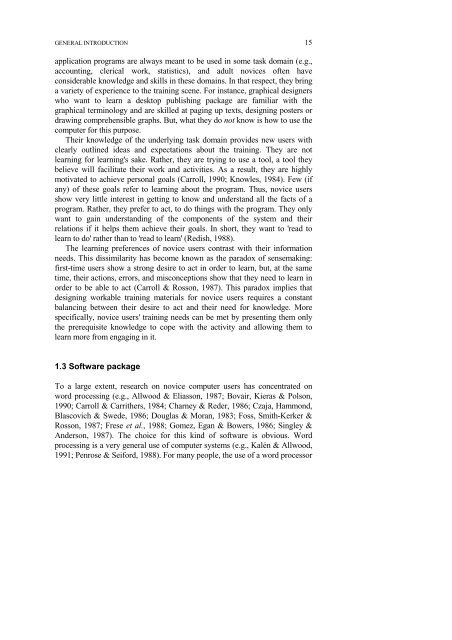MINIMALIST COMPUTER DOCUMENTATION - Universiteit Twente
MINIMALIST COMPUTER DOCUMENTATION - Universiteit Twente
MINIMALIST COMPUTER DOCUMENTATION - Universiteit Twente
You also want an ePaper? Increase the reach of your titles
YUMPU automatically turns print PDFs into web optimized ePapers that Google loves.
GENERAL INTRODUCTION<br />
application programs are always meant to be used in some task domain (e.g.,<br />
accounting, clerical work, statistics), and adult novices often have<br />
considerable knowledge and skills in these domains. In that respect, they bring<br />
a variety of experience to the training scene. For instance, graphical designers<br />
who want to learn a desktop publishing package are familiar with the<br />
graphical terminology and are skilled at paging up texts, designing posters or<br />
drawing comprehensible graphs. But, what they do not know is how to use the<br />
computer for this purpose.<br />
Their knowledge of the underlying task domain provides new users with<br />
clearly outlined ideas and expectations about the training. They are not<br />
learning for learning's sake. Rather, they are trying to use a tool, a tool they<br />
believe will facilitate their work and activities. As a result, they are highly<br />
motivated to achieve personal goals (Carroll, 1990; Knowles, 1984). Few (if<br />
any) of these goals refer to learning about the program. Thus, novice users<br />
show very little interest in getting to know and understand all the facts of a<br />
program. Rather, they prefer to act, to do things with the program. They only<br />
want to gain understanding of the components of the system and their<br />
relations if it helps them achieve their goals. In short, they want to 'read to<br />
learn to do' rather than to 'read to learn' (Redish, 1988).<br />
The learning preferences of novice users contrast with their information<br />
needs. This dissimilarity has become known as the paradox of sensemaking:<br />
first-time users show a strong desire to act in order to learn, but, at the same<br />
time, their actions, errors, and misconceptions show that they need to learn in<br />
order to be able to act (Carroll & Rosson, 1987). This paradox implies that<br />
designing workable training materials for novice users requires a constant<br />
balancing between their desire to act and their need for knowledge. More<br />
specifically, novice users' training needs can be met by presenting them only<br />
the prerequisite knowledge to cope with the activity and allowing them to<br />
learn more from engaging in it.<br />
1.3 Software package<br />
To a large extent, research on novice computer users has concentrated on<br />
word processing (e.g., Allwood & Eliasson, 1987; Bovair, Kieras & Polson,<br />
1990; Carroll & Carrithers, 1984; Charney & Reder, 1986; Czaja, Hammond,<br />
Blascovich & Swede, 1986; Douglas & Moran, 1983; Foss, Smith-Kerker &<br />
Rosson, 1987; Frese et al., 1988; Gomez, Egan & Bowers, 1986; Singley &<br />
Anderson, 1987). The choice for this kind of software is obvious. Word<br />
processing is a very general use of computer systems (e.g., Kalén & Allwood,<br />
1991; Penrose & Seiford, 1988). For many people, the use of a word processor<br />
15
















